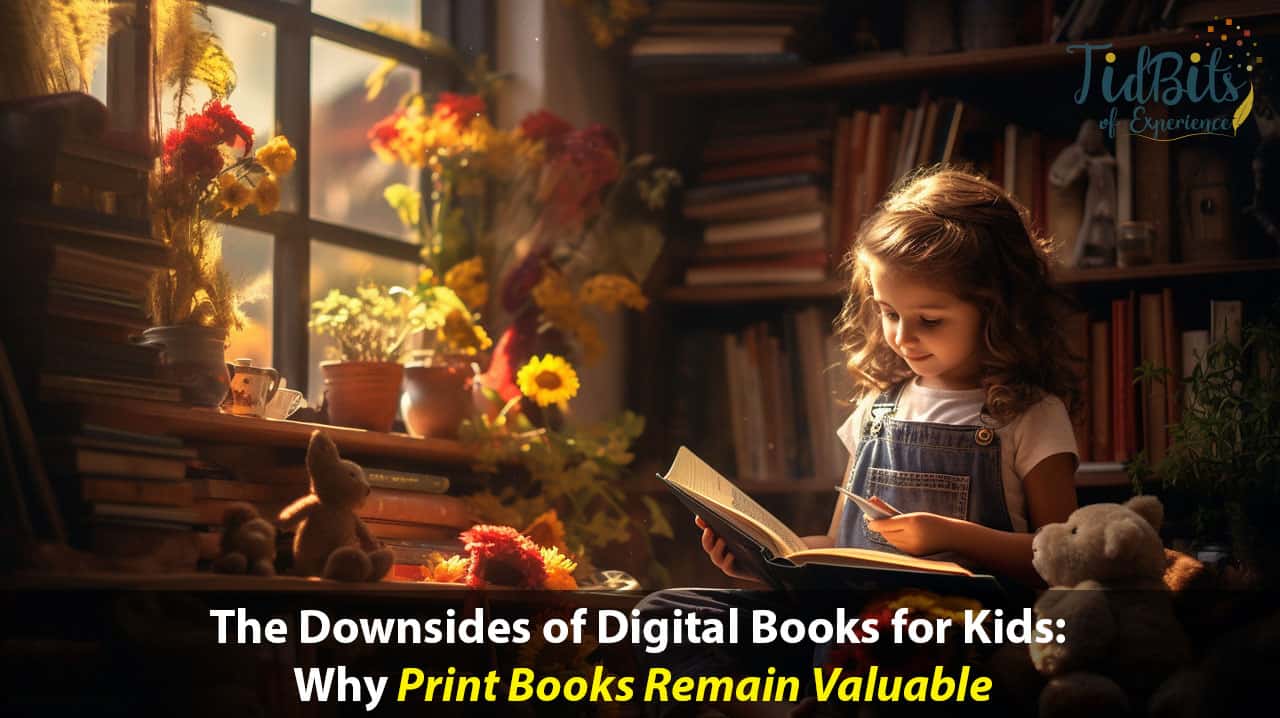Are you confused about whether e-books or traditional books are better for your kid’s reading needs? You’re not alone – this is a question I also grappled with, especially amid the rise of digital learning tools and the COVID-19 pandemic pushing more activities online.
My research found that while e-books might seem convenient and trendy, they come with some significant drawbacks for young readers. Ready to unravel this debate? Let’s dive in!
Key Takeaways
E-books can be challenging for children to retain information compared to physical books, as the tactile experience of turning pages and touching text stimulates memory.
The lack of aesthetic appeal in e-books, such as vibrant covers and illustrations, may cause disinterest or hesitation among young readers.
E-books require a digital device, which can be expensive, prone to breaking, and dependent on regular charging. Physical books do not have this requirement and can be enjoyed anywhere, anytime, without relying on technology.
Sharing is limited with e-books as they cannot be easily borrowed or lent to friends, hindering the development of critical social and communication skills.
Table of Contents
Understanding E-Books

E-books, short for electronic books, are digital versions of traditional paper texts. They offer a world where thousands of stories can be stored in one small device like a Kindle or Nook.
E-books have the advantage of not taking up any physical space on your bookshelves at home, and you don’t need to worry about where to store them. This makes it possible to carry an entire library in your pocket.
Unlike a trip to the bookstore, e-books can be purchased online with just a click of a button – no need to leave the house or even get off your couch! Many platforms, such as Amazon and Goodreads, feature e-books that cover every genre under the sun.
What’s more, some platforms also offer interactive tools like built-in dictionaries and text-to-speech options, which can aid in improving children’s literacy skills.
What Are The Disadvantages of EBooks for Children
E-books can be a disadvantage for children due to their difficulty in retaining information, lack of aesthetic appeal, requirement of a digital device, inability to share with others, and potential for causing eye strain.
Difficulty retaining information
In my experience, one key disadvantage of e-books for children is the difficulty in retaining information. Studies support this observation, suggesting that young readers tend to remember more from printed books compared to their digital counterparts.
The reason? Physical books provide a hands-on experience that stimulates memory. Turning each page and touching the text create sensory impressions that reinforce what’s being read.
E-books, even with interactive tools like animations or built-in dictionaries, can’t mimic this tactile element essential for enhancing memory retention among book lovers — especially children honing their early literacy skills.
Lack of aesthetic appeal

Just picture it – the feel of a new book in your hands, the vibrant colors and exquisite details on the cover that pique your child’s interest. This simple but impactful aesthetic appeal is missing in e-books.
The lack of physicality inherent to digital reading material takes away from this intimate experience offered by traditional books. Let’s not forget how enticing children find the bright illustrations and figures printed on paper! E-books simply cannot replicate this allure, potentially causing disinterest or hesitation among young readers to engage with their e-reader or Kindle instead of a conventional print book.
Plus, there’s nothing quite like a well-organized book collection adorning a shelf—another aspect lost in transition when opting for digital versions, which are hidden inside devices rather than displayed proudly for all to see.
Requirement for a digital device
To access e-books, a digital device such as a tablet, smartphone, or e-reader is necessary. However, this requirement can be a disadvantage for children. Digital devices can be expensive to purchase and maintain.
Additionally, they are prone to breaking and require regular charging. This means that access to e-books is dependent on the availability of a functioning device. In contrast, physical books do not have this requirement and can be enjoyed anywhere at any time without relying on technology.
Inability to share e-books

Sharing is an essential part of the reading experience, allowing children to connect with others and explore different genres and authors. Unfortunately, e-books lack this capability.
Unlike physical books that can be easily borrowed or lent to friends, e-books cannot be shared in the same way. This means that children miss out on the joy of exchanging books and engaging in discussions about their favorite stories.
The inability to share e-books not only limits their exposure to new reading material but also hinders the development of important social and communication skills.
Potential for causing eye strain
E-books can strain our eyes and potentially cause vision problems. Staring at screens for long periods of time can lead to eye fatigue and discomfort. The light emitted from these devices may also disrupt our sleep patterns, making it harder to get a good night’s rest if we read e-books before bedtime.
It’s important to take breaks and limit screen time to protect our eyesight and ensure overall well-being when using e-books.
The Impact of E-Books on Children’s Literacy Skills

E-books have had a significant impact on children’s literacy skills. With the interactive tools they offer, such as built-in dictionaries and text-to-speech options, e-books can help children improve their vocabulary and reading comprehension.
Research has shown that these features can be especially beneficial for children with developmental delays or language difficulties. Additionally, the availability of high-quality e-books makes it easier for parents to engage in parent-child dialogue while reading together, enhancing the child’s understanding of stories and improving their overall literacy skills.
The convenience and accessibility of e-books also encourage independent reading among young readers, fostering a love for books and increasing exposure to different genres. However, despite these advantages, it is important to note that research suggests people generally retain more information from printed books compared to e-books.
Therefore, while e-books can be an effective tool in promoting children’s literacy skills, it is crucial to strike a balance between digital and print resources to ensure well-rounded development in young readers.
Comparing E-Books and Physical Books for Children

It’s essential to consider the pros and cons of e-books and physical books for children to help them reap the maximum benefits of reading.
| Attributes | E-books | Physical Books |
| Aesthetic Appeal | E-books lack the physical appeal of real books. They don’t offer the experience of flipping through pages or admiring beautiful covers. | Physical books have an aesthetic appeal. The process of turning pages, the smell of a new book, and the attractive cover designs make the reading experience more enjoyable. |
| Requirement of Devices | For reading e-books, a digital device is required, which can be expensive and prone to breaking. It also needs to be charged regularly. | No devices are needed for reading physical books. They are ready to be read anytime, anywhere, without the need for charging. |
| Sharing | E-books are not easy to share. It limits the possibility of having discussions and conversations among readers. | Physical books can be shared easily, fostering conversations and discussions among readers. |
| Eye Strain | Reading e-books can cause eye strain and fatigue, especially if children spend prolonged periods staring at the screen. It can even disrupt sleep patterns if read before bedtime. | Physical books do not cause eye strain, making them safer for children’s eyes. Reading physical books before bed does not affect sleep patterns. |
| Memory Retention | Research suggests that information from e-books is harder to remember than that from physical books. | Research indicates that children tend to remember more information from physical books. |
| Cost | The price difference between e-books and physical books can influence purchasing decisions. Sometimes e-books might be cheaper. | Physical books may be more expensive than e-books since the cost may also include the printing, shipping, and manufacturing process. |
While both e-books and physical books promote reading and build relationships among young book lovers, it’s critical to consider the above points when choosing the best option for children.
How E-Books Can Affect the Reading Experience for Children

E-books have the potential to greatly impact the reading experience for children. One of the main advantages is that e-books allow children to carry an entire library with them wherever they go, thanks to digital devices like Kindles and Nooks.
This convenience eliminates the need for bulky physical books and allows kids to have access to a wide range of reading material at their fingertips.
Additionally, e-books often come with interactive tools that can enhance a child’s reading experience. Features such as text-to-speech and built-in dictionaries help improve literacy skills by providing immediate definitions and pronunciations of unfamiliar words.
Some e-books even include interactive hotspots, sound effects, and animated pictures that engage young readers and stimulate their imagination.
However, it’s important to note that there are some drawbacks associated with e-books as well. Research suggests that people tend to retain information better when reading from printed books compared to e-books.
In addition, unlike physical books, which offer a tactile experience through flipping pages and feeling the weight of the book in their hands, e-books lack aesthetic appeal.
Another concern is eye strain caused by prolonged screen time while reading digitally. Staring at screens for extended periods can lead to fatigue and potentially vision problems in children.
Overall, while e-books offer many advantages in terms of accessibility and interactivity, they also come with certain disadvantages when it comes to memory retention and eye health.
It’s essential for parents and educators to carefully consider these factors before deciding whether or not e-books are suitable for enhancing a child’s reading experience.
Frequently Asked Questions About The Most Beneficial Books For Kids
What are the disadvantages of e-books for children?
Some disadvantages of e-books for children include eye strain and fatigue from staring at screens, decreased comprehension and retention compared to physical books, distractions from other apps or notifications on devices, and potential negative effects on sleep patterns.
Are traditional books more beneficial for children than e-books?
Traditional books offer benefits such as tactile interaction with pages, visual cues that aid in comprehension, the opportunity to develop fine motor skills through turning pages, and a break from screen time. They also promote a deeper connection with reading material and can be shared easily without technology barriers.
Can e-books have adverse effects on children’s cognitive development?
There is some research suggesting that excessive exposure to screens through e-books may have adverse effects on children’s cognitive development. These effects can include reduced attention spans, impaired critical thinking skills, and difficulties with focus and concentration.
How can parents encourage their children to read traditional books instead of e-books?
Parents can encourage their children to read traditional books by creating a print-rich environment at home with accessible bookshelves filled with interesting titles. They can also set aside dedicated reading time where devices are turned off or restricted, engage in shared reading experiences together, visit libraries or bookstores as a family outing, and model reading behaviors themselves by demonstrating a love for physical books.
Conclusion
In conclusion, while e-books offer convenience and interactive features, there are several disadvantages that make traditional books more beneficial for children. The lack of aesthetic appeal, the requirement of a digital device, the inability to share with others, the potential for causing eye strain, and difficulty retaining information all contribute to the preference for physical books.
Ultimately, both formats have their merits, but the unique sensory experience and tangible connection that traditional books provide make them an irreplaceable source of joy and learning for children.

